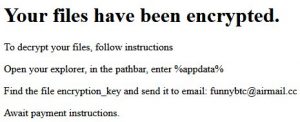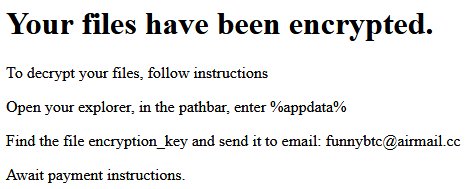 This article has been made to explain to you what is the .xcry7684 files virus and show you ways via which you can remove it and try to recover your encrypted files.
This article has been made to explain to you what is the .xcry7684 files virus and show you ways via which you can remove it and try to recover your encrypted files.
New ransomware has been recently discovered by security researchers to append the .xcry7684 file extension on the computers of victims. The virus aims to encrypt the files on the computers that have been infected by it. The ransomware then adds the .xcry7684 file extensions to the encrypted files and requests from victims to pay ransom in order to be able to unlock their documents again. If your computer has been recently infected by .xcry7684 ransomware, we suggest you to read this article thoroughly.

Threat Summary
| Name | Xcry Ransomware |
| Type | Ransomware, Cryptovirus |
| Short Description | Aims to render your files temporary unusable until you pay rasom to get them to work once again. |
| Symptoms | Most of the files on your computer have the .xcry7684 file extension and cannot be opened. A ransom note, called HOW_TO_DECRYPT_FILES.html appears. |
| Distribution Method | Spam Emails, Email Attachments, Executable files |
| Detection Tool |
See If Your System Has Been Affected by malware
Download
Malware Removal Tool
|
User Experience | Join Our Forum to Discuss Xcry Ransomware. |
| Data Recovery Tool | Windows Data Recovery by Stellar Phoenix Notice! This product scans your drive sectors to recover lost files and it may not recover 100% of the encrypted files, but only few of them, depending on the situation and whether or not you have reformatted your drive. |

XCry Ransomware – Distribution Methods
The primary method used to distribute the malicious files of XCry ransomware is reported to be conducted via e-mails that allegedly contain malicious e-mail attachments. The ransomware may send cunning e-mails, known as malspam, and they often pretend that the files embedded are:
- Invoices.
- Receipts.
- Tickets.
- Booking documentation.
- Banking documents.
The crooks rely mainly on the idea that the victim will open them while believing the attachments carry important files. In reality, the files may be JavaScript files, executable files and even malicious Microsoft Word or Adobe Reader files, containing Macros embedded in them.
Besides via e-mail, the crooks who are behind the XCry ransomware may also spread infection files by directly uploading them on several websites, where the files may pretend to be cracks or patches of programs. Most users who are looking for torrents could also be exposed, as the XCry ransomware may hide the infection files in torrents as well.

.xcry7684 Files Virus – Analysis
Once an infection with the .xcry7684 file extension ransomware has commenced, the virus may perform several malicious activities, that eventually lead to the file encryption.
The first chain of activities in which the XCry ransomware takes part is to drop it’s payload on the infected computer. The ransomware may situate it’s main infection file on the machine it has compromise. The sample detected by researchers has the following IOCs:
→SHA256:e32c8b2da15e294e2ad8e1df5c0b655805d9c820e85a33e6a724b65c07d1a043
Name:7475713df82b2a81b2d32715a94c2b63
Once the file is activated, it imports the following Windows functions in KERNEL32.dll:
→ GetLastError
EnterCriticalSection
GetSystemInfo
GetModuleFileNameW
TryEnterCriticalSection
FreeLibrary
QueryPerformanceCounter
GetTickCount
TlsAlloc
VirtualProtect
LoadLibraryA
DeleteCriticalSection
GetCurrentProcess
GetCurrentProcessId
UnhandledExceptionFilter
VirtualLock
GetProcAddress
GetModuleHandleA
VirtualUnlock
SetUnhandledExceptionFilter
GetStartupInfoA
GetSystemTimeAsFileTime
TerminateProcess
InitializeCriticalSection
VirtualQuery
VirtualFree
TlsGetValue
Sleep
TlsSetValue
GetCurrentThreadId
VirtualAlloc
SetLastError
LeaveCriticalSection
As soon as it’s done with this, the ransomware may also drop and display it’s primary ransom note file. It is called HOW_TO_DECRYPT_FILES.html, having the following contents:
Your files have been encrypted.
To decrypt your files, follow instructions
Open your explorer, in the pathbar, enter %appdata%
Find the file encryption_key and send it to email: funnybtc@airmail.cc
Await payment instructions.
Furthermore, the XCry ransomware may also perform other activities on the computers it has compromised, such as to edit the Windows Registry Editor, more specifically add value entries for it’s files to run automatically on Windows boot in the Run and RunOnce sub-keys:
→ HKEY_LOCAL_MACHINE\Software\Microsoft\Windows\CurrentVersion\Run
HKEY_CURRENT_USER\Software\Microsoft\Windows\CurrentVersion\Run
HKEY_LOCAL_MACHINE\Software\Microsoft\Windows\CurrentVersion\RunOnce
HKEY_CURRENT_USER\Software\Microsoft\Windows\CurrentVersion\RunOnce
In addition to this, the XCry ransomware may also create files that execute WMIC,exe with the following comands:
→ sc stop VVS
sc stop wscsvc
sc stop WinDefend
sc stop wuauserv
sc stop BITS
sc stop ERSvc
sc stop WerSvc
cmd.exe /C bcdedit /set {default} recoveryenabled No
cmd.exe /C bcdedit /set {default} bootstatuspolicy ignoreallfailures
C:\Windows\System32\cmd.exe” /C vssadmin.exe Delete Shadows /All /Quiet

XCry Ransomware – Encryption Process
Once the XCry ransomware has infected a computer and taken control, the ransomware does not waste any time with it’s encryption procedure. The virus may cleverly skip all files, located in Windows system directories, but other than that all of the files you use on often basis are enciphered. These files often end up to be the following types:
- Documents.
- Videos.
- Images.
- Archives.
- Virtual Drive files.
Once the files are encrypted, they assume the following appearance:

Remove XCry Ransomware and Restore .xcry7684 Files
Before starting to remove the .xcry7684 ransomware from your computer, we would recommend that you do a fresh backup fo your files first, even though they are encrypted.
For the removal of the XCry ransomware virus, we would suggest that you try using the instructions underneath this article. They have been divided in manual and automatic removal instructions. If the manual removal does not seem to help you out, and the threat remains persistent on your PC, we would advise you to do what most malware researchers recommend and that is to run a scan with an anti-malware software. Such program aims to look in-depth your machine in order to detect and remove any malicious files and objects, related to XCry ransomware residing on your computer.
If you want to try and restore files, encrypted by this ransomware, we would suggest that you try out the alternative file recovery methods we have posted below. They have been made to help you restore as many encrypted files by this ransomware, but they come with no guarantee to be able to restore all of your encrypted files.
- Step 1
- Step 2
- Step 3
- Step 4
- Step 5
Step 1: Scan for Xcry Ransomware with SpyHunter Anti-Malware Tool



Ransomware Automatic Removal - Video Guide
Step 2: Uninstall Xcry Ransomware and related malware from Windows
Here is a method in few easy steps that should be able to uninstall most programs. No matter if you are using Windows 10, 8, 7, Vista or XP, those steps will get the job done. Dragging the program or its folder to the recycle bin can be a very bad decision. If you do that, bits and pieces of the program are left behind, and that can lead to unstable work of your PC, errors with the file type associations and other unpleasant activities. The proper way to get a program off your computer is to Uninstall it. To do that:


 Follow the instructions above and you will successfully delete most unwanted and malicious programs.
Follow the instructions above and you will successfully delete most unwanted and malicious programs.
Step 3: Clean any registries, created by Xcry Ransomware on your computer.
The usually targeted registries of Windows machines are the following:
- HKEY_LOCAL_MACHINE\Software\Microsoft\Windows\CurrentVersion\Run
- HKEY_CURRENT_USER\Software\Microsoft\Windows\CurrentVersion\Run
- HKEY_LOCAL_MACHINE\Software\Microsoft\Windows\CurrentVersion\RunOnce
- HKEY_CURRENT_USER\Software\Microsoft\Windows\CurrentVersion\RunOnce
You can access them by opening the Windows registry editor and deleting any values, created by Xcry Ransomware there. This can happen by following the steps underneath:


 Tip: To find a virus-created value, you can right-click on it and click "Modify" to see which file it is set to run. If this is the virus file location, remove the value.
Tip: To find a virus-created value, you can right-click on it and click "Modify" to see which file it is set to run. If this is the virus file location, remove the value.
Before starting "Step 4", please boot back into Normal mode, in case you are currently in Safe Mode.
This will enable you to install and use SpyHunter 5 successfully.
Step 4: Boot Your PC In Safe Mode to isolate and remove Xcry Ransomware





Step 5: Try to Restore Files Encrypted by Xcry Ransomware.
Method 1: Use STOP Decrypter by Emsisoft.
Not all variants of this ransomware can be decrypted for free, but we have added the decryptor used by researchers that is often updated with the variants which become eventually decrypted. You can try and decrypt your files using the instructions below, but if they do not work, then unfortunately your variant of the ransomware virus is not decryptable.
Follow the instructions below to use the Emsisoft decrypter and decrypt your files for free. You can download the Emsisoft decryption tool linked here and then follow the steps provided below:
1 Right-click on the decrypter and click on Run as Administrator as shown below:

2. Agree with the license terms:

3. Click on "Add Folder" and then add the folders where you want files decrypted as shown underneath:

4. Click on "Decrypt" and wait for your files to be decoded.

Note: Credit for the decryptor goes to Emsisoft researchers who have made the breakthrough with this virus.
Method 2: Use data recovery software
Ransomware infections and Xcry Ransomware aim to encrypt your files using an encryption algorithm which may be very difficult to decrypt. This is why we have suggested a data recovery method that may help you go around direct decryption and try to restore your files. Bear in mind that this method may not be 100% effective but may also help you a little or a lot in different situations.
Simply click on the link and on the website menus on the top, choose Data Recovery - Data Recovery Wizard for Windows or Mac (depending on your OS), and then download and run the tool.
Xcry Ransomware-FAQ
What is Xcry Ransomware Ransomware?
Xcry Ransomware is a ransomware infection - the malicious software that enters your computer silently and blocks either access to the computer itself or encrypt your files.
Many ransomware viruses use sophisticated encryption algorithms to make your files inaccessible. The goal of ransomware infections is to demand that you pay a ransom payment to get access to your files back.
What Does Xcry Ransomware Ransomware Do?
Ransomware in general is a malicious software that is designed to block access to your computer or files until a ransom is paid.
Ransomware viruses can also damage your system, corrupt data and delete files, resulting in the permanent loss of important files.
How Does Xcry Ransomware Infect?
Via several ways.Xcry Ransomware Ransomware infects computers by being sent via phishing emails, containing virus attachment. This attachment is usually masked as an important document, like an invoice, bank document or even a plane ticket and it looks very convincing to users.
Another way you may become a victim of Xcry Ransomware is if you download a fake installer, crack or patch from a low reputation website or if you click on a virus link. Many users report getting a ransomware infection by downloading torrents.
How to Open .Xcry Ransomware files?
You can't without a decryptor. At this point, the .Xcry Ransomware files are encrypted. You can only open them once they are decrypted using a specific decryption key for the particular algorithm.
What to Do If a Decryptor Does Not Work?
Do not panic, and backup the files. If a decryptor did not decrypt your .Xcry Ransomware files successfully, then do not despair, because this virus is still new.
Can I Restore ".Xcry Ransomware" Files?
Yes, sometimes files can be restored. We have suggested several file recovery methods that could work if you want to restore .Xcry Ransomware files.
These methods are in no way 100% guaranteed that you will be able to get your files back. But if you have a backup, your chances of success are much greater.
How To Get Rid of Xcry Ransomware Virus?
The safest way and the most efficient one for the removal of this ransomware infection is the use a professional anti-malware program.
It will scan for and locate Xcry Ransomware ransomware and then remove it without causing any additional harm to your important .Xcry Ransomware files.
Can I Report Ransomware to Authorities?
In case your computer got infected with a ransomware infection, you can report it to the local Police departments. It can help authorities worldwide track and determine the perpetrators behind the virus that has infected your computer.
Below, we have prepared a list with government websites, where you can file a report in case you are a victim of a cybercrime:
Cyber-security authorities, responsible for handling ransomware attack reports in different regions all over the world:
Germany - Offizielles Portal der deutschen Polizei
United States - IC3 Internet Crime Complaint Centre
United Kingdom - Action Fraud Police
France - Ministère de l'Intérieur
Italy - Polizia Di Stato
Spain - Policía Nacional
Netherlands - Politie
Poland - Policja
Portugal - Polícia Judiciária
Greece - Cyber Crime Unit (Hellenic Police)
India - Mumbai Police - CyberCrime Investigation Cell
Australia - Australian High Tech Crime Center
Reports may be responded to in different timeframes, depending on your local authorities.
Can You Stop Ransomware from Encrypting Your Files?
Yes, you can prevent ransomware. The best way to do this is to ensure your computer system is updated with the latest security patches, use a reputable anti-malware program and firewall, backup your important files frequently, and avoid clicking on malicious links or downloading unknown files.
Can Xcry Ransomware Ransomware Steal Your Data?
Yes, in most cases ransomware will steal your information. It is a form of malware that steals data from a user's computer, encrypts it, and then demands a ransom in order to decrypt it.
In many cases, the malware authors or attackers will threaten to delete the data or publish it online unless the ransom is paid.
Can Ransomware Infect WiFi?
Yes, ransomware can infect WiFi networks, as malicious actors can use it to gain control of the network, steal confidential data, and lock out users. If a ransomware attack is successful, it could lead to a loss of service and/or data, and in some cases, financial losses.
Should I Pay Ransomware?
No, you should not pay ransomware extortionists. Paying them only encourages criminals and does not guarantee that the files or data will be restored. The better approach is to have a secure backup of important data and be vigilant about security in the first place.
What Happens If I Don't Pay Ransom?
If you don't pay the ransom, the hackers may still have access to your computer, data, or files and may continue to threaten to expose or delete them, or even use them to commit cybercrimes. In some cases, they may even continue to demand additional ransom payments.
Can a Ransomware Attack Be Detected?
Yes, ransomware can be detected. Anti-malware software and other advanced security tools can detect ransomware and alert the user when it is present on a machine.
It is important to stay up-to-date on the latest security measures and to keep security software updated to ensure ransomware can be detected and prevented.
Do Ransomware Criminals Get Caught?
Yes, ransomware criminals do get caught. Law enforcement agencies, such as the FBI, Interpol and others have been successful in tracking down and prosecuting ransomware criminals in the US and other countries. As ransomware threats continue to increase, so does the enforcement activity.
About the Xcry Ransomware Research
The content we publish on SensorsTechForum.com, this Xcry Ransomware how-to removal guide included, is the outcome of extensive research, hard work and our team’s devotion to help you remove the specific malware and restore your encrypted files.
How did we conduct the research on this ransomware?
Our research is based on an independent investigation. We are in contact with independent security researchers, and as such, we receive daily updates on the latest malware and ransomware definitions.
Furthermore, the research behind the Xcry Ransomware ransomware threat is backed with VirusTotal and the NoMoreRansom project.
To better understand the ransomware threat, please refer to the following articles which provide knowledgeable details.
As a site that has been dedicated to providing free removal instructions for ransomware and malware since 2014, SensorsTechForum’s recommendation is to only pay attention to trustworthy sources.
How to recognize trustworthy sources:
- Always check "About Us" web page.
- Profile of the content creator.
- Make sure that real people are behind the site and not fake names and profiles.
- Verify Facebook, LinkedIn and Twitter personal profiles.















